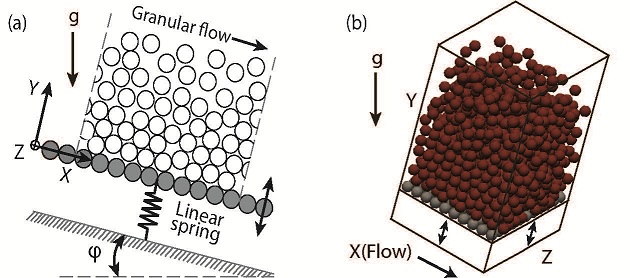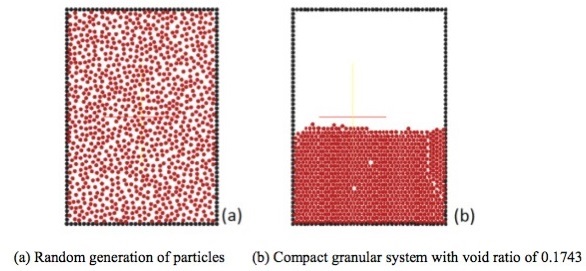
Mechanics & Applied Mathematics group
Mechanical Engineering
Indian Institute of Technology Kanpur
 |
Prasad SonarCurrent position: PhD candidate.Advisor: Ishan Sharma Research: Granular flow down a flexible inclined plane. (DEM simulations, experiments and stability theory). |
INDEX
- Gravity Driven Granular Flows Over a Flexible Base.(July 2014 on-words)
- Triaxial testing of granular materials.(Jan-Jun 2014)
Gravity Driven Granular Flows Over a Flexible Base.
Wednesday 3 July 2013.IIT Kanpur.Advisor: Ishan Sharma.

Discrete and continuous systems are commonly studied individually, but seldom together.
Indeed, granular flows are typically studied through flows over a rigid base. We investigate the behaviour of granular flows over an inclined, flexible base.
The flexible base is modeled as a rigid platform mounted on springs and has one degree of freedom. The base vibrations are introduced by the flow.
We simulate such flows through a discrete element method and compare with experiments.
We find that a flexible base increased the upper limit of the inclination up to which a steady flow is possible by at least 3 degrees.
This may have important implications in applications such as conveyor belts and chutes.
we also attempt to characterize the onset of unsteady granular flow in our study by making contact with stability analysis performed for viscous fluid flow over soft solids and for dense granular flow over rigid inclined plane.
Triaxial testing of granular materials.

We are simulating triaxial shear test on granular materials to calculate various material properties of granular mass, e.g., angle of repose, etc. Angle of repose is the measure of maximum slope at which grains on the heap are stable. Investigation on heap-formation in granular materials and parameters affecting the angle of repose via simulations by employing discrete element method (DEM) has already been done by my colleagues.
Since angle of repose is a macroscopic property, the intention is to find its dependence on the microscopic parameters, such as, spring stiffness k, damping coefficient c, and coefficient of friction, which are embedded in the interaction laws between two colliding grains. The purpose of triaxial shear testing is to compare the recent results obtained via heap-formation.
We believe that the parameters, which may affect the system considerably, are the void ratio and coordination number that define the packing characteristics of a granular system. Hence, it is very important to have precise control over these parameters in the computational model.
Currently, We are working on making randomly generated particles as compact as possible in a rectangular box. For this, a code has been written that reduces the box area, while compacting the particles under gravity and external vibration till a desired void ratio is achieved. A hydrostatic state must be obtained before applying a compressive load to the specimen to let the system evolve until it fails. The stresses will be calculated in the granular media, which will be used to evaluate the angle of repose.